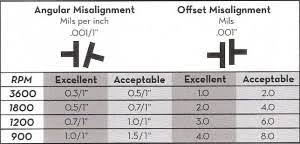VibrAlign and Fixturlaser have done what we can to make the precision shaft alignment process quicker and easier for the end user of our tools. To assist maintenance personnel during an alignment a tolerance table “pops up” on the display unit screen (of our tools) when entering dimensions for the machines being aligned. The tolerances are based on industry standards for typical equipment like pumps and motors.


That does not necessarily mean that these tolerances are appropriate for every alignment or piece of machinery that you maintain. Many machines require tighter alignment tolerances, some others may be more tolerant of additional angular or offset misalignment, or both!
Since tolerances for alignment are based on speed of rotation, I will use that as the reference for comparison.
EXAMPLES:
- Machine 1 operates at a speed of 1200 RPM. According to the typical industry standard tolerance, an excellent alignment would be an angularity of +/- 0.7mils/1” with an offset of +/- 3.0 mils. However, the manufacturer of this machine has designed the coupling assembly in a way that allows for additional misalignment. They state that the angularity can be 3.5 mils/1” (or better) with an offset of 27mils (or better). This is a big difference. A mechanic can save time, if needed, by aligning to the “looser” allowed tolerance.
- Machine 2 operates at 10,500 rpm, very sensitive to misalignment. Based on the progression of the tolerance table, the allowable tolerance is essentially zero for both angular and offset misalignment. This may very well be the case or perhaps not. Knowing of the sensitivity of the machine, the designers may have built in some cushion for this.
The point is this, know the alignment tolerance for the machine(s) you are working on. The manufacturer of the machine will give you the proper tolerances for the entire assembly with consideration to all components in a machine, not just the coupling. Coupling manufacturers will give a tolerance for the coupling alone. Be sure you know the shaft alignment tolerance for the machine as a unit.



